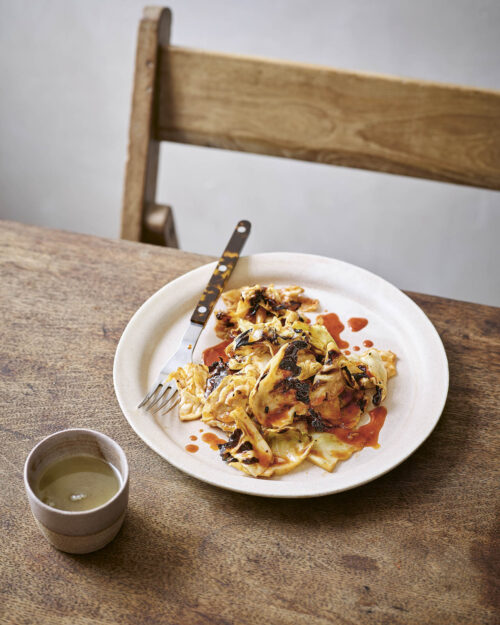Cabbage is one of the most commonly eaten vegetables in Korea and one that everyone loves. I’m a huge fan too, and love how versatile this humble brassica can be. In this delicious recipe from Su Scott’s Rice Table: Korean Recipes & Stories To Feed The Soul, the cabbage is cooked fast and hot so that it chars on the edges but retains some bite, and then dressed in a spicy, sweet and tart gochujang dressing.
The dish works fabulously as part of a Korean meal but it’s also wonderful with non-Korean food – it works particularly well with grilled or barbecued lamb chops; the dressing balancing the fatty meat beautifully. You can even enjoy it as a main with plain rice and a fried egg garnish. It’s a hugely versatile dish.
Leftovers keep well in the fridge for a few days.
Read my in-depth book review of Su Scott’s Rice Table.
Korean Charred Cabbage in Warm Gochujang Vinaigrette (Yangbaechu Gui)
Ingredients
- ½ white cabbage
- 1 tbsp vegetable oil
- ½ tsp sea salt flakes
- ¼ tsp freshly cracked black pepper
- 2 tsp golden granulated sugar
- 2 tsp soy sauce
- 2 tsp gochujang (Korean fermented chilli paste)
- ½ tsp gochugaru (Korean red pepper flakes)
- 2 tbsp extra virgin olive oil
- 2 garlic cloves, minced
- 2 tbsp cider vinegar
Instructions
- Prepare the cabbage by removing any wilted outer leaves. Slice the cabbage in half lengthways so you have two wedges. Remove the cores and tear the leaves into large, bite-sized pieces. The edges of the pieces will appear uneven and that is perfectly fine. Transfer the torn cabbage to a large mixing bowl and soak it in cold water for 10 minutes. Drain well.
- Toss the cabbage with the vegetable oil, salt and black pepper.
- Preheat the grill (broiler) to high and place a large empty baking tray under the grill to heat up.
- Carefully remove the hot tray from the oven and place the seasoned cabbage onto it. You should notice the sizzling sound as the cold cabbage hits the scorching hot tray. Grill for 7 minutes, turning once or twice to ensure you have an even char. You should notice the edges catching in places. The inside of the cabbage will soften but still retain some bite. When ready, set aside.
- Meanwhile, combine the sugar, soy sauce, gochujang and gochugaru in a small mixing bowl. Give it a good stir and set aside. Put the olive oil and garlic into a small, cold saucepan. Gently warm up over a low heat for a couple of minutes to infuse. I start the pan from cold to prevent the garlic from burning too quickly, so be patient and keep the heat on very low. After 2 minutes or so, you should notice the garlic begin to smell fragrant. Add the soy sauce and gochujang mixture to the pan, stirring continuously to incorporate it into the oil. Continue cooking on low for 2 minutes.
- Whisk in the cider vinegar and bring it to a warm temperature without boiling. It should only take about 30 seconds. Remove from the heat and set aside.
- In a large mixing bowl, combine the cabbage and warm gochujang vinaigrette. Serve warm or cold. Stored in an airtight container, it will keep well for a few days in the fridge.
This dish is a delight, and already repeated in the short time we’ve been cooking from Su’s book.
Made the recipe? Let us know how you got on in the comments.
You may also enjoy other Korean recipes and content here.
Browse our full collection of recipes from around the world
Kavey Eats received a review copy of Rice Table by Su Scott from publishers Quadrille. Book photography by Toby Scott. Home cooking photography by Kavita Favelle.







Please leave a comment - I love hearing from you!8 Comments to "Korean Charred Cabbage in Warm Gochujang Vinaigrette (Yangbaechu Gui)"
Lovely! Thanks for sharing
It’s a regular for us, so good!
I love grilled and charred cabbage but I’d never tried it Korean style before. It was delicious, the only problem is that I’ve run out of gochugaru and I need to wait to find more so I can make this again!
You can get it online if need be, though we usually pick it up from either the big Chinese supermarket in Bristol, or a small Korean and Japanese grocery shop in Cardiff.
Finally made this, omg 🤤 t
Isn’t it totally an OMG recipe??? 🙂
When you say “grill for 7 minutes, you mean place in broiler for 7 minutes, correct?
Yes, I think only Americans call it a broiler. Here’s in the UK we call it a grill but as you can see in step 3, a grill = a broiler.